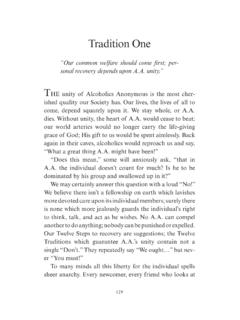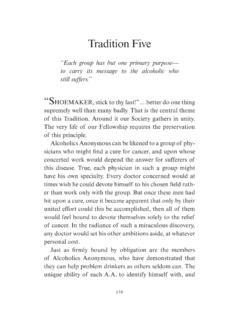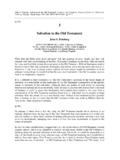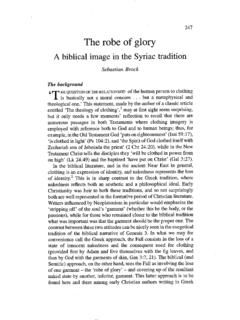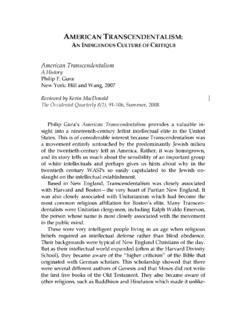Transcription of Exploring the Invocation to Patanjali - BKS Iyengar Yoga ...
1 Exploring the Invocation to PatanjaliBy Peggy CadyYogena cittasya padena vacamMalam sarirasyaca vaidyakena Yopakarottam prvaram muninam Patanjalim pranjaliranato smi Abahu purusakaram Sankha cakrasi dharinam Sahasra sirasam svetam Pranamami PatanjalimHari Hey OmTo the noblest of sages, Patanjali , who gave us yoga for serenity of mind, grammar for purity of speech and medicine for the perfection of the body, I salute. I salute before Patanjali whose upper body has a human form, whose arms hold a conch, and disc and a sword, who is crowned by a thousand headed cobra. Oh incarnation of Adisesa my humble salutations to thee. I m not someone who chants.
2 Don t get me wrong; I m not against chanting. If I feel compelled to chant, I like to understand what I m saying and why I am doing it. Especially when the chant is in a language I don t understand. What spirits am I invoking?At the beginning of yoga class we often chant the Invocation to Patanjali . We do a call-and-response chant with the teacher. The first time I went to a class, it happened we chanted. I didn t know what it was all about. Was this some quasi-religious ritual? Did I want to do this? I decided to wait and listen. Respectfully. The next time I hummed along. (It was kind of catchy.) After that I maybe repeated the few syllables I could grasp.
3 It was in Sanskrit who speaks Sanskrit? Being curious, I finally raised my hand one day and asked what it was all about. I m glad I chanting the Invocation we are taking a moment to acknowledge and pay respect the ancient roots of Iyengar Yoga, the teachings which have been handed down over the centuries and the instructors from whose experience and wisdom we benefit. Starting the class with the chant is a way to symbolize that we are leaving our regular daily life behind, letting go of our concerns and giving ourselves over to the practice of yoga. It is both a physical and aural stimulus; we hear the sounds and feel the vibrations in our body.
4 We begin to tune into ourselves. Now that I ve been taking classes for a few years, I can appreciate taking the time for the Invocation . I really do value the lessons, the teachers, the volunteers and what yoga has done for me. I love leaving work, family and all the daily crises behind and tuning in to this special, deep focus and letting go. Here s my exploration of the Invocation and Patanjali . I found out what it means and how to pronounce the words. There s even a link where you can play an audio file of Mr. Iyengar chanting the Invocation . So, as to this fellow Patanjali , he is believed to have lived between 200 and 450 That s a long time span.
5 He became a mythical figure with legendary qualities, and the research is sketchy on whether or not he was one person or several different people. He is credited with purifying body, mind and speech with his writings on medicine, ayurveda and grammar. He is particularly known for codifying the Yoga Sutras, 196 aphorisms in Sanskrit, from which the modern practice of yoga is derived. Previously these teachings had been handed down orally. Patanjali s writ-ings have had resonance and relevance with readers through the centuries and have been translated many times. The Sutras laid out a system of practice by which one can attain a pure state free of illusion.
6 The practice begins with the adoption of a fivefold ethic (yama), .. nonviolence, truthfulness, non-stealing, sexual restraint, and non-attachment. It is followed by the adoption of five virtues (niyama) purity, contentment, The first time I went to a class, it we chanted. 12austerity, study, and dedication. These practices inhibit the negative influences of being in the world. After adopting a lifestyle centered on yama and niyama, one begins the step-by-step adoption of the asanas (postures), breath control, control over the sense, concentration, and meditation, each of which should lead to the goal of samadhi (variously described as absorption or liberation).
7 Iyengar translated and commented on the philoso-phy of the Yoga Sutras of Patanjali in his book Light On the Yoga Sutras of Patanjali . The Iyengar tradition and yoga prac-tice are grounded in these teachings. Through this practice we can transform ourselves to gain physical health, vitality, mental clarity, wisdom, emotional serenity and poise, and attain the goal of yoga: kaivalya, liberation from the bondage of worldly desires and actions, and union with the Divine. 2 What follows are two articles by Geeta Iyengar , about the Invocation to Patanjali . The first is a translation and comments on the Invocation itself. The second article is from a teacher training paper, which discusses the symbolism of the Patanjali statue.
8 (You ll want to stay on the good side of him.) 1 Majumdar, Sachindra Kumar. Introduction to Yoga Principles and Practice. Secaucus, : Citadel Press, The Yoga Sutras of Patanjali : A New Translation and Commentary. Edited by Georg Feuerstein. Folkstoone, UK: Dawson, 1979. #ixzz1IJ5vmvVM2 Iyengar . Light on the Yoga Sutras of Patanjali . Thorsons/Harper Collins, cover notes. London, UK: Iyengar s Comments and TranslationThe two slokas (verses) that we chant to invoke Lord Patanjali begin the Bhojavritti, Bhoj s commentary on the Yoga Sutras. It says, first of all, that Lord Patanjali is considered to be the incarnation of Adhishesha, the cobra, which is the seat for the Lord Vishnu, the very creator of this world.
9 It is said he took birth three different times, giving three different sciences for people to improve themselves. The first is cittasya padena vacam To purify the mind (citta), purify the consciousness, Patanjali gave the science of yoga (yogena) to us. To purify our use of words (pada) and speech (vacca), he gave a commentary on grammar to us, so that our use of words and way of speaking is clarified, distinct and sarirasya ca vaidyakenaTo remove the impurities (malam) of the body (sarira), he gave us the science of medicine (vaidyakena).yopakarottam pravaram muninamLet me go near the one who has given these things to pranjalir anato smiLet me bow down my head with my folded hands to Lord PatanjaliThen after knowing the work of this Lord, the second stanza says what Lord Patanjali looks like.
10 To do any meditation first the form has to be in front of the purusakaramFrom the hand up to the head he has the shape (karam) of a human (purusa).sankha carkrasi dharinamIn his hand he is holding the conch (sankha) and disc (cakra) sahasra sirasam svetamOn top of his head (sirasam) he has got a thousand (sahasra) hoods of the cobra, because he is the incarnation of Adishesha, the greatest cobra. Svetam means patanjalim I bow down to PatanjaliWe chant so that at the very beginning that feeling of sancti-fication comes from inside, with the feeling of surrendering oneself, because nothing can be learned in this world unless you have the humility to learn.
